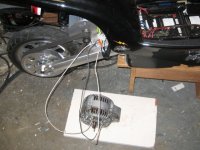mwkeefer
1 MW
John,
Just put the nylon gears back in, seperate the mag ring and drill the thing from the backside divits to reduce weight and finally drill the living crap out of your covers - I'm talking 1" or bigger diameter holes... and run it without any lube - try teflon power like you use for a bowling ball - be sure you have it mounted to a suspension fork and if you still need to loose some weight... well start unwinding every third phase or so... maybe a cromo axle or somthing stronger and lighter than the factory axle? Magnesium is awful light (and as strong as aluminum if cast properly) - Half Kidding
Um... fellas maybe title should include the word Electric, ie: "ES DIY Electric Motor Challenge" - or can I submit the my wenkle design rotary gas powered ebike/lev hub motor? - (Kidding and no, I won't do the photoshop)
I've only ever built 1 electric motor from scratch, I was 6 years old and it was nails, magnets and that Green xmas wire for windings - add 9v battery and a flick of the finger (can you say pedalec) and I was hooked for life.
-Mike
Just put the nylon gears back in, seperate the mag ring and drill the thing from the backside divits to reduce weight and finally drill the living crap out of your covers - I'm talking 1" or bigger diameter holes... and run it without any lube - try teflon power like you use for a bowling ball - be sure you have it mounted to a suspension fork and if you still need to loose some weight... well start unwinding every third phase or so... maybe a cromo axle or somthing stronger and lighter than the factory axle? Magnesium is awful light (and as strong as aluminum if cast properly) - Half Kidding
Um... fellas maybe title should include the word Electric, ie: "ES DIY Electric Motor Challenge" - or can I submit the my wenkle design rotary gas powered ebike/lev hub motor? - (Kidding and no, I won't do the photoshop)
I've only ever built 1 electric motor from scratch, I was 6 years old and it was nails, magnets and that Green xmas wire for windings - add 9v battery and a flick of the finger (can you say pedalec) and I was hooked for life.
-Mike



